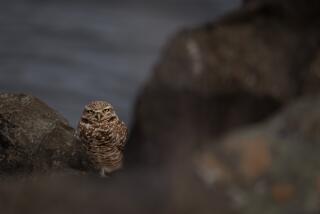Least Bell’s vireos nesting in Playa Vista area
- Share via
A bird the size of a soda can is ruffling the waters at Playa Vista, and bird-lovers are greeting the news with chirps of joy.
Biologists and amateur birders have discovered two pairs of federally endangered least Bell’s vireos nesting at or near the development.
One pair of the mousy gray-and-white songsters have taken up residence in the restored riparian corridor at the northern edge of the Playa Vista community. Their nest — about the size of an average human hand — holds four eggs, typical for the species, biologists say.
The other pair have nested in a willow thicket on a state-owned ecological reserve just west of the Playa Vista freshwater marsh at the southwest corner of Lincoln and Jefferson boulevards. An identification band on the female indicates that she migrated from Camp Pendleton. At least one baby has shown its head in that nest.
Although least Bell’s vireos have previously been spotted foraging for insects in the Ballona area, “there is no record of their having nested there for more than a hundred years,” said Edith Read, a biologist who manages the freshwater marsh.
The least Bell’s vireo (pronounced VEER-ee-oh) was listed as a state endangered species by the California Fish and Game Commission in 1980 and as a federally endangered species in 1986. The birds were once common in the Central Valley, but the removal of river habitat forced most of them out and by the 1940s birders found no sign of them. The birds have held on in parts of Southern California and northwestern Baja California.
Consulting biologist Dan Cooper, who since 2003 has done quarterly bird surveys for Playa Vista, was the first to observe the small vireos hanging around the riparian corridor. During the March-to-June breeding season, he said, he visits the area weekly so that he doesn’t miss any significant arrivals.
In April, he heard the distinctive sound of a male vireo’s song. Males sing, whereas females give calls or chirps, Cooper said.
“I first heard the thing singing, giving a full song,” he said. “I heard other calls with it — the contact call of the female, which I hadn’t heard in a long time.”
He finally spotted the feathered flirts, who were snapping at and chasing each other. Last month, Read enlisted a federally permitted biologist to search for the nest, and he found it right off the trail in an area of the riparian corridor with cattails and willow, cottonwood and sycamore trees.
Meanwhile, a volunteer birder had been observing a vireo near the marsh. After a week or so, Cooper said, “we determined there were two different [male] birds holding two different territories.” On Monday, Cooper said, he located the nest near the marsh and saw “at least one little head poking up as it was getting fed.”
Several years ago, Playa Vista began moving and restoring the 25-acre riparian corridor where Howard Hughes, the famed aviator and engineer, had built a drainage ditch. Patti Sinclair, co-president of Playa Vista, said the vireo discoveries vindicated the developer’s oft-maligned efforts to remove non-native plants, plant native species and install the freshwater marsh on the west side of Lincoln. In addition to creating habitat, the marsh was designed to control flooding and to treat storm-water runoff.
“It means what we’ve been trying to do has succeeded,” Sinclair said.
Read added that key to success for the freshwater wetlands system was having “connectivity and adjacency.”
“As far as we know, these birds aren’t recolonizing habitat that was lost,” Cooper said. “It seems to be a genuine expansion into a new area because of human modification of the habitat.”
Marcia Hanscom, co-director of the nonprofit Ballona Institute and a longtime Playa Vista critic, had mixed emotions about the discoveries. She recalled that she and others had sued Playa Vista in the late 1990s over its plans to eliminate habitat suitable to rare or endangered birds such as the least Bell’s vireo and the southwestern willow flycatcher. Despite the challenge, Playa Vista continued to bulldoze habitat, she said.
“Had Playa Vista not bulldozed away the willow thickets … it is possible this species would have returned to the Ballona Valley even sooner,” she said of the vireos. Playa Vista has attracted cowbirds, which are known to lay eggs in least Bell’s vireo nests.
Read acknowledged that cowbirds were a potential concern and said she and others would monitor any interactions.
“The whole idea behind this habitat is that it would be more or less self-sustaining,” she said. “We don’t want to get into the situation of managing individual species at the expense of other species.”
To hear the song of a least Bell’s vireo, visit the U.S. Fish and Wildlife Service website.
More to Read
Sign up for Essential California
The most important California stories and recommendations in your inbox every morning.
You may occasionally receive promotional content from the Los Angeles Times.











